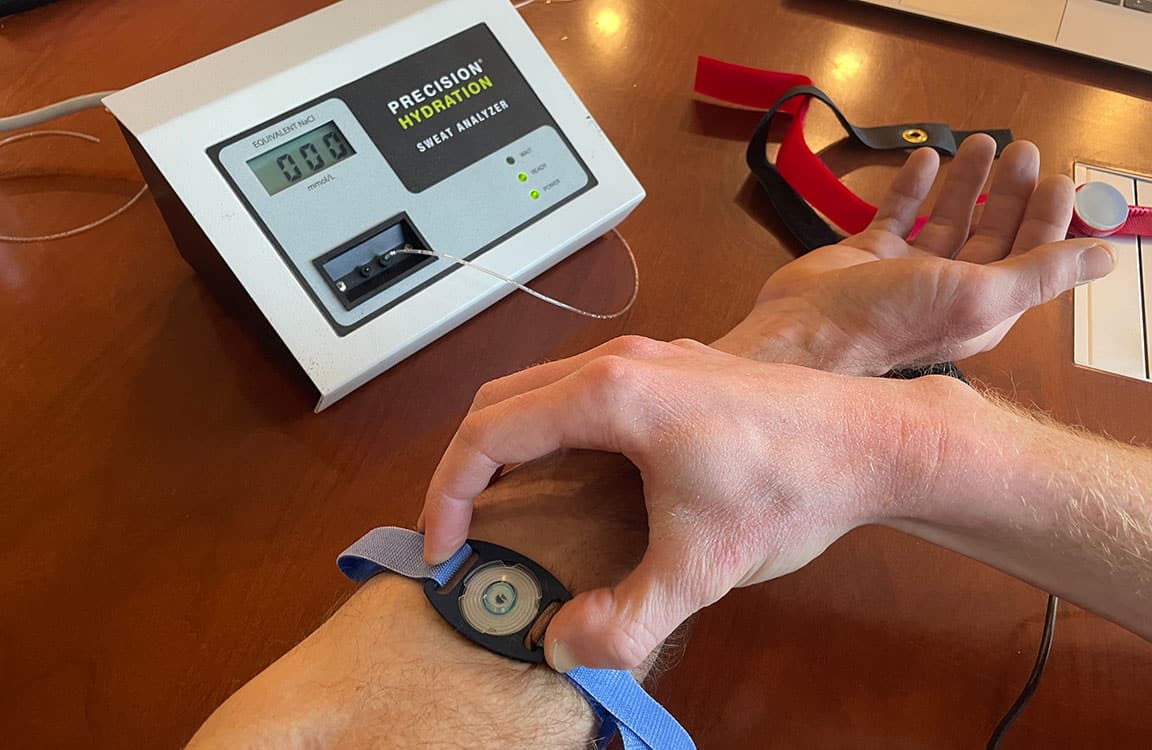
Sweat Testing for Athletes: What it is and how it can help your performance
By Addison Smith,
CTS Expert Coach
Everybody sweats, but how we sweat is very individual. Sweat rates can be affected by your fitness level, how acclimated you are to the environment, and even the medications you’re taking. And the composition of sweat changes, too. If you learn more about your individual sweat response, you can plan your hydration and nutrition strategies so you can perform at your best in all conditions. If you are looking to improve your performance, sweat testing is an easy, non-invasive, and affordable step to take.
What is Sweat Testing?
Sweat testing is the collection and analysis of a sample of sweat. For athletes, we’re looking for the sweat sodium concentration to calculate an estimate of how much sodium you lose in a given volume of sweat. Your sweat sodium concentration is highly individual; some athletes lose more than others, and that can influence your sodium replenishment strategy before, during, and after exercise.
Sweat Sodium Testing vs. Sweat Rate Testing
Testing a sample of sweat to determine the sodium concentration is just one part of the overall story. How much you sweat during exercise is another important part of the equation. Sweat rate testing is easy and something you can do at home. For a very rough estimate, weigh yourself without clothing before and after a workout. The difference represents fluid loss, and dividing by the duration of the workout in hours gives you your hourly sweat rate.
For a more precise calculation of sweat rate, use the following procedure. Use the metric system (i.e., grams, liters) for all measurements and remember that 1 gram = 1 milliliter and 1 kilogram = 1000 milliliters.
- Before training, go to the bathroom and then weigh yourself without clothing.
- Perform your workout and record/remember the volume of fluids you consume.
- After training, remove clothing, towel dry, empty your bladder, and then weigh yourself.
- To account for fluid loss in urine during and after training (assuming you’re not collecting it), use the average adult urine volume of about 300 milliliters (300 grams).
- To calculate sweat rate: ((weight before training – weight after training) + weight of fluid consumed during training – weight of urine lost) / exercise duration in hours
Keep in mind, sweat rate varies with air temperature, humidity, your fitness level, your exertion level, and your hydration status. This means you should calculate sweat rate in a variety of scenarios to learn how environmental conditions and exercise intensity change your sweat response.
Now that you know how much you sweat, it’s time to consider the composition of your sweat. That’s where sweat sodium testing comes into play.
Why Sweat Sodium Concentration Matters
Sodium’s most important role in the body is to maintain fluid balance between extracellular (e.g., blood) and intracellular (e.g. tissue) spaces. Remember from high school chemistry that water flows through semipermeable membranes from regions of high fluid concentration (more dilute solution) to regions of lower fluid concentration (less dilute solution). The normal range for blood sodium concentration is between 135 – 145 millimole/Liter. When sodium concentration in the blood drops, water moves from the blood into tissues. As a result, swelling is a symptom of hyponatremia (blood sodium concentration ≤ 135 mmol/L) because water moved into tissues – including the brain – in an effort to keep blood sodium concentration within normal limits.
The amount of sodium lost through sweat may play a role in maintaining blood sodium levels within normal limits, and hence maintaining fluid balance within the body. People often associate hyponatremia with overconsumption of plain water, but for endurance and ultraendurance athletes it can also result from sweat sodium losses over a prolonged period – even when athletes consume electrolytes in drinks and foods. Knowing how your sweat rate and the concentration of sodium in your sweat can help athletes manage their nutrition strategies to keep blood sodium levels within the normal range.
Other roles for sodium during exercise
Although maintaining fluid balance is sodium’s primary role, it plays other roles during exercise as well. Sodium is an important component of sports drinks and foods because it enhances fluid absorption, particularly when combined with carbohydrates. Adding sodium to a sports drink (up to 400-500 mg/L) also makes the drink more palatable, which encourages athletes to drink more frequently and consume more fluid each time they take a drink. Sodium and other electrolytes may also play a minor role in exertional muscle cramps, but sodium depletion is no longer considered a major or direct cause of cramping. For more on the modern view on muscle cramps, read this.
Why Testing Your Sweat Sodium Test is Important
Most sedentary or moderately active individuals have no problem meeting their sodium needs, but endurance athletes who lose sodium through sweat over a couple or many hours, sodium ingestion and hydration status become key components to maintaining performance over long training bouts and races.
You might be surprised to know that individual athletes have a unique sweat sodium concentration which is only moderately affected by heat acclimation and training status (more on that later). Athletes can lose as little as 200 mg of sodium per liter of sweat or as much as 2000 mg of sodium per liter of sweat. That’s a huge range!
Although research is still inconclusive on whether there is an ideal percentage of sodium replenishment during exercise to maintain or improve performance, we know athletes should consume some sodium during exercise. The consensus from current scientific literature is that for events longer than 4+ hours, athletes should replenish 50-80% sodium lost via sweat. Dr. Alan McCubbin, a researcher in this area and author of several peer-reviewed studies on the topic (McCubbin 2022), confirmed this during a recent presentation to CTS Coaches. Even in this ballpark replacement range, knowing your sweat sodium concentration is crucial as your required intake range could variety by thousands of milligrams over a long endurance endeavor.
Practical Example
Let’s take a realistic race example to illustrate how significant this range is for endurance performance: An athlete loses .68 Liters per hour of sweat over the course of a 5-hour period, for a total of 3.4L of fluid losses.
If this athlete had a low sweat sodium concentration of 500 mg of sodium per liter of sweat, they’d lose 1700 mg of sodium in 5 hours (500mg x 3.4L = 1700mg). Replacing 50-80% of that would mean consuming 800 – 1360 mg of sodium during the same period.
If this athlete had a high sweat sodium concentration of 1200 mg of sodium per liter of sweat, they’d lose 4080 mg of sodium in 5 hours (1200mg x 3.4L = 4080mg). Replacing 50-80% of that would mean consuming 2040 – 3264 mg of sodium during the same period.
On a practical level, those two scenarios would require dramatically different hydration and nutrition strategies. There’s a 2.4x difference in the sodium replenishment recommendation! Sodium intake does not need to be overly precise, but you don’t want to make a big miss, either. Consuming too much sodium can lead to gastrointestinal distress and consuming too little sodium not only prevents optimal body functionality but contributes to dehydration and potentially hyponatremia.
► Free Cycling Training Assessment Quiz
Take our free 2-minute quiz to discover how effective your training is and get recommendations for how you can improve.
How Sweat Sodium Testing Works
Sweat sodium testing is easy, non-invasive, and doesn’t even require exercise. Although there are a few testing protocols out there, the most convenient uses electrical stimulation on the sweat glands of one forearm to induce localized sweating. We collect a small sample of sweat and analyze it on the spot. It is important to note, the test calculates whole body sweat sodium concentration from the sample collected on the forearm, taking into consideration regional differences between anatomical sites (Baker, 2017). From start to finish, the testing process and consultation takes about 45 minutes. CTS offers Sweat-Sodium Testing at our Colorado Springs Lab using the technology created by Precision Hydration.
How to Use Sweat Sodium Test Results
Your sweat sodium concentration is highly individual and significantly influenced by genetics. This means baseline sweat sodium concentration remains relatively constant over time. Heat acclimation and training status affect sweat sodium concentration, but not as dramatically as they affect sweat rate. The adaptations to heat exposure and improved fitness allow athletes to start sweating sooner and more profusely. Sweat glands have the ability to retain sodium, thus diluting sweat and allowing you to increase fluid loss without as great an increase in sodium loss. Because of this, fluctuations in sweat sodium concentration due to heat adaptation and fitness level are relatively minor. So, you might go from 700 mg/L to 500 mg/L (both in the Low range on the Precision Hydration chart), but you’re not likely to go from 1000 mg/L to 300 mg/L (from very high to very low).
Once you get an idea for your sweat sodium concentration setpoint or typical range based on heat adaptation and fitness level, you can design your hydration strategy to provide adequate sodium replenishment based on your hourly sweat rate. Here’s an example:
Step 1: Determine your current sodium intake
Determine your current sodium intake during exercise, either before you get tested or at least before you make changes based on test results. To do this, look up the sodium content of the foods and sports drinks you normally consume during workouts. There will likely be day-to-day variation, so record your intake over the course of a week or more to get a reasonable picture of what “normal” looks like for you.
Step 2: Get tested
You can get a Sweat Test at CTS in Colorado Springs. As a personal example, my sweat test indicates I have a sweat sodium concentration around 1000 mg/L. Based on Precision Hydration’s protocols, this comes out to a recommendation for 1000mg of sodium per 32 ounces of fluid during a 3+ hour event or training session. Note, the recommendations change based on event duration and expected environmental conditions. However, rather than viewing test results and recommendations as absolute, I recommend using them as a starting point.
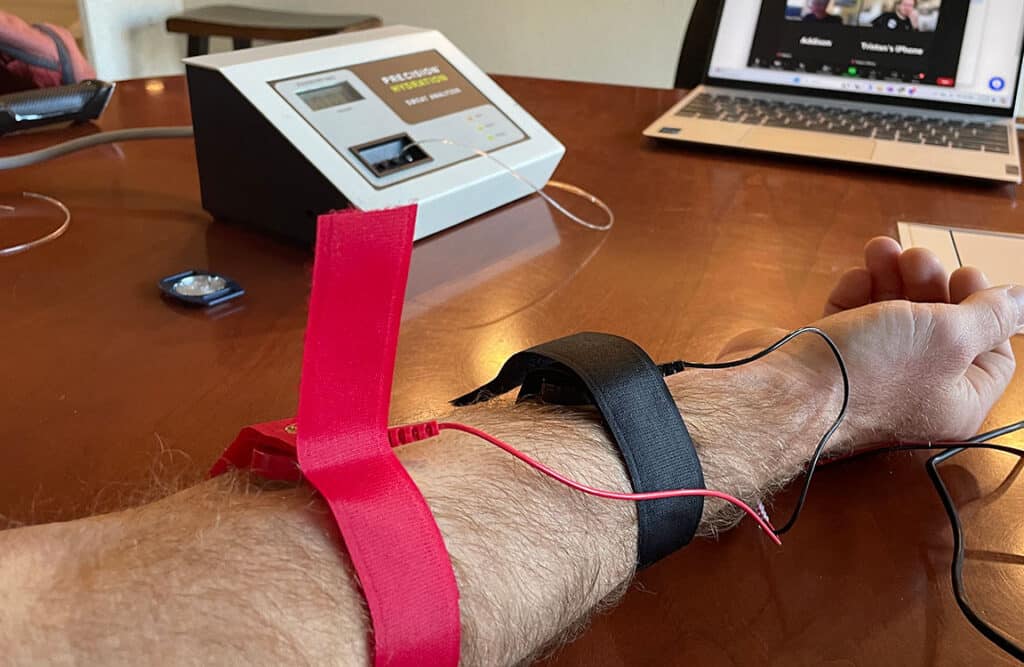
In this step, a small and painless electrical current is applied to induce sweating under a gel disc located under the red side.
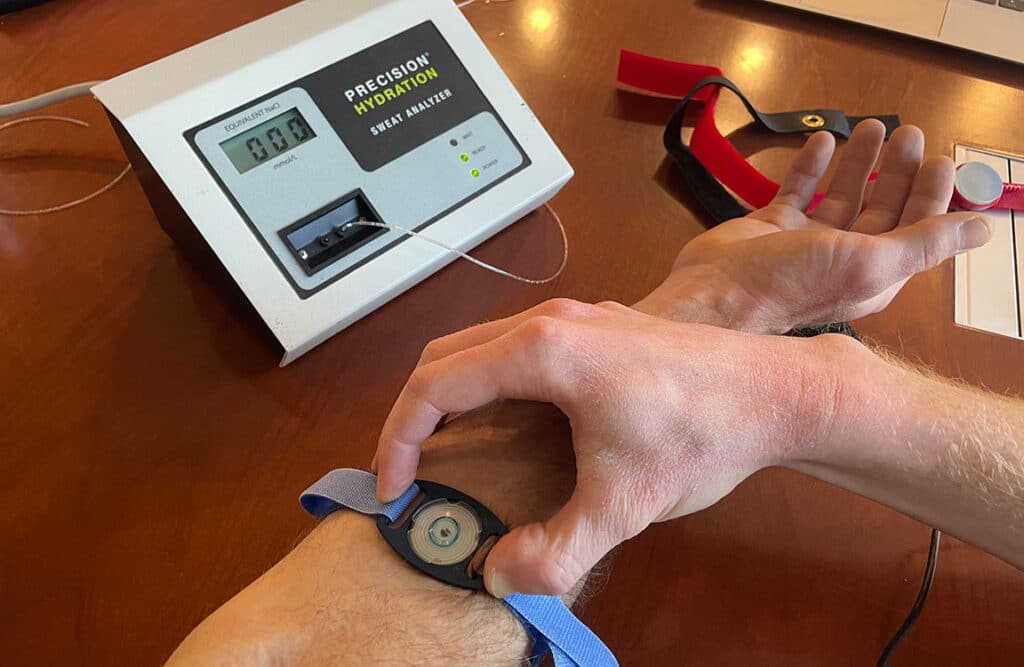
In this step, a collection disc is applied tightly to the location previously occupied by the red contact. Sweat is collected in a curled plastic capillary tube.
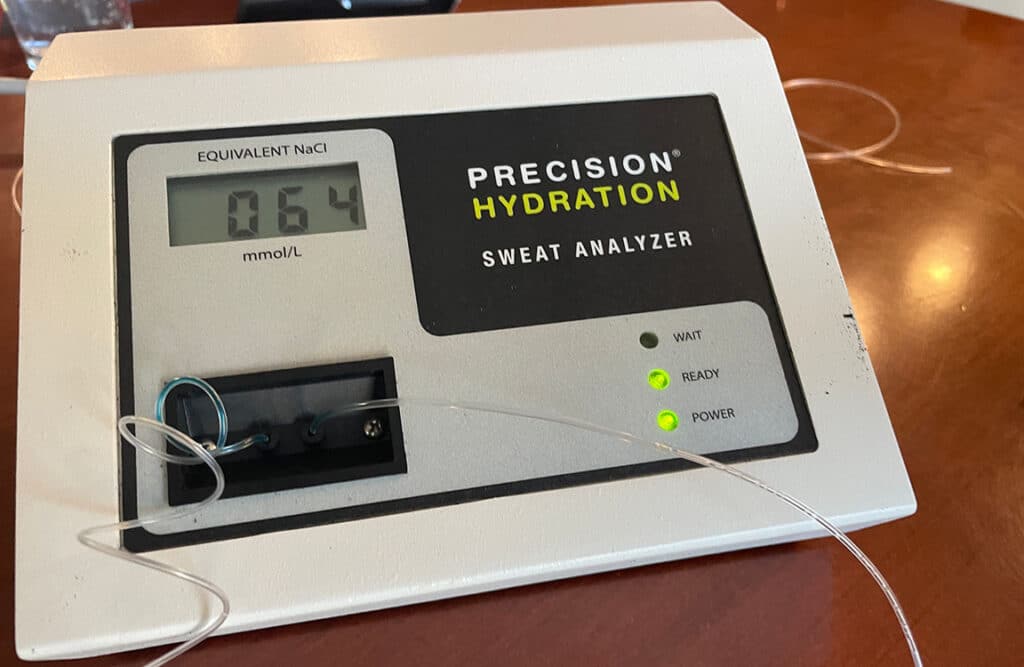
The sweat collected is analyzed in this device and the value (e.g. 64 mmol/L in this image) is input into software that accounts for regional differences in sweat production at various sites on the body. So, 64 mmol/L is not the final output value for this person’s sweat sodium concentration. A straight conversion of mmol/L to mg/L of sodium would be 1472 mg/L. For this test, the individual’s sweat sodium concentration was calculated to be 1310 mg/L.
Step 3: Put the recommendations to the test
Adaptability is key to success in endurance sports. Therefore, it’s important to understand your sensitivity to sodium intakes above and below recommended amounts. Over a series of workouts in similar conditions and at similar intensity levels, test your sodium intake recommendations. Consume the recommended amount, substantially less, and substantially more. In my example, this meant consuming 100%, 50%, and then 150% of the recommended 1000mg of sodium per 32 ounces of fluid during 3-hour training sessions. Personally, I felt good and performed equally well at 50% (500 mg) and 100% (1000 mg) per 32 ounces. But I felt nauseated after two hours when I consumed 150% of the recommended amount (1500 mg).
References
Baker, Lindsay B. “Sweating Rate and Sweat Sodium Concentration in Athletes: A Review of Methodology and Intra/Interindividual Variability.” Sports medicine (Auckland, N.Z.) vol. 47,Suppl 1 (2017): 111-128. doi:10.1007/s40279-017-0691-5
Baker, Lindsay B. “Sweating Rate and Sweat Sodium Concentration in Athletes: A Review of Methodology and Intra/Interindividual Variability.” Sports medicine (Auckland, N.Z.) vol. 47,Suppl 1 (2017): 111-128. doi:10.1007/s40279-017-0691-5
Barnes, Kelly A et al. “Normative data for sweating rate, sweat sodium concentration, and sweat sodium loss in athletes: An update and analysis by sport.” Journal of sports sciences vol. 37,20 (2019): 2356-2366. doi:10.1080/02640414.2019.1633159
McCubbin, Alan J. “Modelling sodium requirements of athletes across a variety of exercise scenarios – Identifying when to test and target, or season to taste.” European journal of sport science vol. 23,6 (2023): 992-1000. doi:10.1080/17461391.2022.2083526
► FREE Mini-Course: Learn How to Maximize Your Limited Training Time
Learn step-by-step how to overcome limited training time and get faster. Walk away with a personalized plan to increase your performance.
"*" indicates required fields

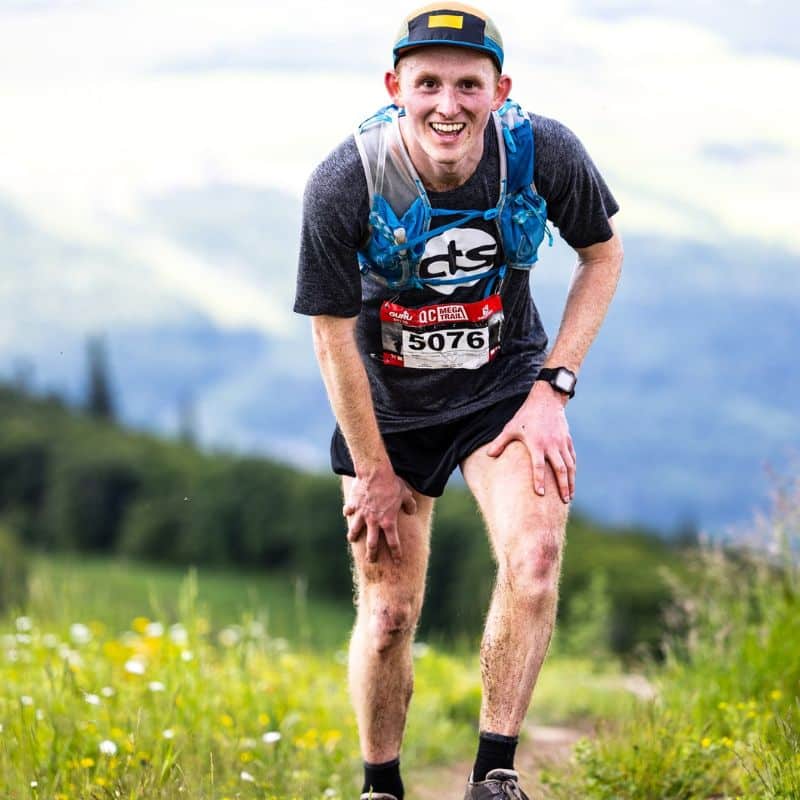

Comments 8
Pingback: The Complete Ultramarathon Checklist: What to Pack for Race Day - CTS
I have done these test to solve my cramping issue and over hydration of water. After testing I failed to follow the recommended guidelines for hydration and sodium on one race and got behind on sodium which caused me to started to cramp late in the race. So the lesson I learned is to drink even when it’s cool and windy at the beginning if your sodium is in your water. Once I started following it I haven’t had any issues.
Do you have the sweat sodium concentration backwards in your heat adaption scenario? Wouldn’t it go down, not up? That is what you state directly above, but then you say you might go from 500mg/l to 700 …, , Wouldn’t it be the other way around?
Hey Cary,
Thanks for the typo catch! Yes one’s sweat sodium concentration might decrease from 700mg/l to 500mg/l (not increase) in a heat adaptation scenario. The main take-home message would still be that this potential decrease in sweat sodium concentration is very small relative to the spectrum of largely genetically-determined sweat sodium concentration differences between athletes, which is why knowing your ball park sweat sodium concentration value is so crucial.
We will be making the correction to the article. Thanks again for pointing the typo out!
Great info. Please consider offering this “sweat” testing at the different camps you have. Thank you. David
David, We will have this testing available at our Brevard Camp on May 1st.
Great info but do you have any recommendations for an in-home or in-the-field test for sodium concentrations?